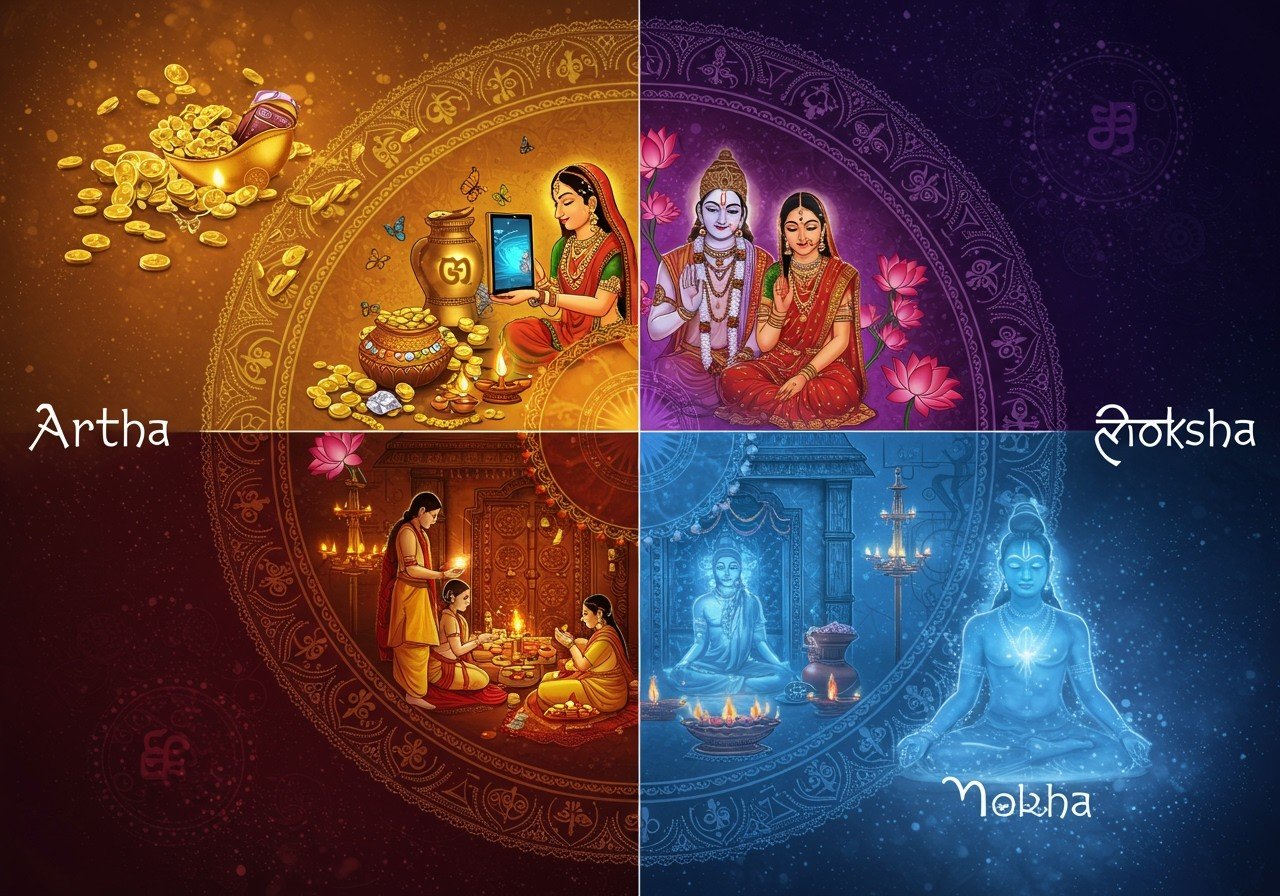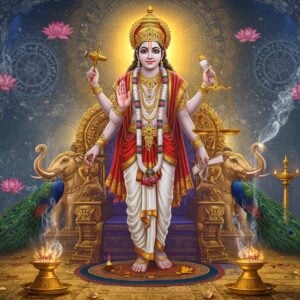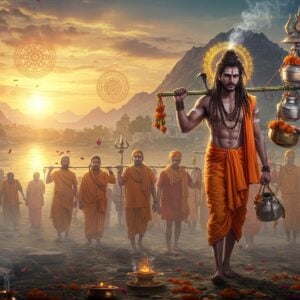Artha, Kama, Dharma, Moksha: The Four Pillars of Hindu Life

In Hindu philosophy, ‘Artha, Kama, Dharma, Moksha’ form the foundation for a balanced and meaningful life. These four pillars offer a comprehensive framework, guiding individuals through the complexities of life with clarity and purpose. By understanding these principles, we can align ancient wisdom with modern values for personal growth and societal well-being.
Artha: The Pursuit of Prosperity
Understanding Artha
Artha refers to the pursuit of wealth and material success. It is not just about accumulating riches but ensuring stability and security in life. Ethical acquisition and management of resources are key to achieving true prosperity. Artha also involves social responsibility, using wealth to benefit society.
Integration with Modern Life
For today’s professionals, balancing Artha with ethical considerations is essential. This involves:
- Acquiring wealth through honest means, contributing to stable financial growth.
- Contributing to community welfare, fostering a culture of giving back to society.
- Ensuring financial stability for family, providing a secure foundation for loved ones.
Artha should be pursued with a focus on creating a positive impact on society while fulfilling personal needs. Consider enhancing your financial journey with authentic puja items for prosperity, available at poojn.in.
Kama: The Pursuit of Desires
Understanding Kama
Kama signifies the pursuit of desires and pleasures in life. It’s not just about physical enjoyment but also emotional fulfillment. Art, music, love, and culture form the essence of Kama. By embracing these, individuals celebrate life’s beauty.
Balancing Desires
Desires should align with personal values and societal norms. This balance prevents indulgence from leading to hedonism. Here’s how:
- Find joy in simple pleasures, appreciating the everyday beauty surrounding us.
- Respect family and community responsibilities, maintaining a harmonious balance.
- Pursue passions that enrich life, exploring creative outlets and meaningful pursuits. Celebrate special occasions and express your affection with traditional gifts from poojn.in.
Modern life offers countless distractions. Staying mindful of genuine desires ensures harmony with responsibilities.
Dharma: The Principle of Righteousness
Defining Dharma
Dharma embodies duty, righteousness, and moral order. It guides ethical decision-making and fulfilling societal roles. Dharma varies with life stages and professions. Adaptability is key.
Practicing Dharma
To live by Dharma:
- Make choices with integrity, upholding moral principles in daily decisions. Enhance your daily rituals and practices with authentic puja items, strengthening your connection to Dharma. Explore our collection at poojn.in.
- Fulfill responsibilities to family and society, contributing to collective well-being.
- Embrace lifelong learning, continuously seeking knowledge and personal growth.
Maintaining social harmony and personal integrity enriches life. Dharma encourages individuals to act thoughtfully and responsibly.
Moksha: The Ultimate Goal of Liberation
Exploring Moksha
Moksha is liberation from the cycle of birth and death. It represents spiritual fulfillment and self-realization. Achieving Moksha brings eternal peace.
Paths to Moksha
Different paths lead to this ultimate goal:
- Meditation fosters inner peace, creating tranquility and clarity of mind. Find meditation accessories and spiritual guidance resources at poojn.in to support your journey towards Moksha.
- Self-discipline strengthens resolve, cultivating focus and determination.
- Devotion nurtures spiritual growth, deepening connection with the divine.
Incorporating these practices daily brings one closer to Moksha. It provides purpose beyond material pursuits. Poojn.in offers a wide selection of spiritual items to support your meditation practice and spiritual journey. Discover our collection at poojn.in.
Integrating the Four Pillars for a Balanced Life
Interconnection of Artha, Kama, Dharma, and Moksha
These pillars form a holistic life framework. Balancing them ensures well-being and fulfillment.
Practical Strategies
To integrate these principles:
- Set goals aligned with values, creating a roadmap for a purposeful life. Discover a wide range of products at poojn.in to support your spiritual practices.
- Prioritize family and community welfare, nurturing meaningful relationships.
- Practice mindfulness in everyday actions, cultivating present moment awareness.
Cultural traditions reinforce these concepts. Reflecting on personal journeys aligns actions with guiding principles. Learn more about Hindu Gods and Goddesses.
Embrace this timeless wisdom for a balanced, meaningful life. You can explore a range of spiritual products and resources to support your journey on Poojn.in.
FAQs on Artha, Kama, Dharma, Moksha: The Four Pillars of Hindu Life
What is the significance of Artha, Kama, Dharma, and Moksha?
Artha, Kama, Dharma, and Moksha are the four pillars of Hindu life, providing a framework for a balanced and fulfilling existence. They address different aspects of human life: duty, prosperity, pleasure, and liberation.
How do Artha and Kama relate to each other?
Artha and Kama are intertwined, representing the material and emotional aspects of life. Artha focuses on acquiring wealth ethically, while Kama encourages enjoying pleasures responsibly, both contributing to overall well-being.
What is Dharma in the context of these four pillars?
Dharma embodies duty, righteousness, and moral order, guiding ethical decision-making. It ensures the pursuit of Artha and Kama aligns with societal norms and personal integrity, fostering a balanced and meaningful life. Explore the power of mantras in daily life.
Why is Moksha considered the ultimate goal?
Moksha represents liberation from the cycle of birth and death, signifying spiritual enlightenment. It transcends material and worldly desires, bringing lasting peace and self-realization, the ultimate purpose of life according to Hindu philosophy. Find meditation accessories for your spiritual journey on Poojn.in.
Can you pursue Artha and Moksha simultaneously?
Balancing Artha and Moksha is a challenging yet achievable path. It requires aligning material success with spiritual growth through ethical practices and a focus on long-term spiritual goals. Seek guidance on your spiritual journey.
What role does Kama play in a fulfilling life?
Kama, the pursuit of pleasure and desires, adds joy and satisfaction to life. Enjoying life’s pleasures responsibly, within the boundaries of Dharma, contributes to overall happiness and contentment. Learn about Hindu fasting practices and their significance.
How can one achieve a balance between the four pillars?
Balancing Artha, Kama, Dharma, and Moksha involves understanding their interdependence. Moderation, clear priorities, and ethical values maintain harmony among these pillars, leading to a fulfilling life.
What is the difference between Artha and Moksha?
Artha focuses on material prosperity while Moksha aims for spiritual liberation. Artha involves acquiring external wealth, while Moksha seeks inner peace and transcends worldly desires. Delve deeper into Hindu scriptures for spiritual understanding.


